Dual-UAV Payload Transportation Using Optimized Velocity Profiles via Real-Time Dynamic Programming
Abstract
1. Introduction
- Small number of parameters in the algorithm that has to be considered. This list of parameters includes the mass of the vehicles, the mass of the payload, the power consumption model, and tuned normalization parameters.
- The approach takes into account for the thrust regulation between the two UAVs while optimizing the lateral transport.
- Parameters required for our approach can also be identified using already existing techniques. Some of the parameters required for multi-UAV systems can also be estimated using the method presented in study [27].
- Training data-sets are not required once the parameters of the model are available.
- The optimized velocity decision is obtained in real-time to achieve either time savings or energy savings.
2. System Model
2.1. Whole System Translational Dynamics
2.2. Individual UAV Rotational Dynamics
3. Algorithm Description
3.1. Phase 1: Infinite Stage Problem
3.2. Phase 2: Finite Stage Problem
3.3. Implementation
| Algorithm 1: DP sweep for RTDP algorithm for dual-hexrotor-payload system |
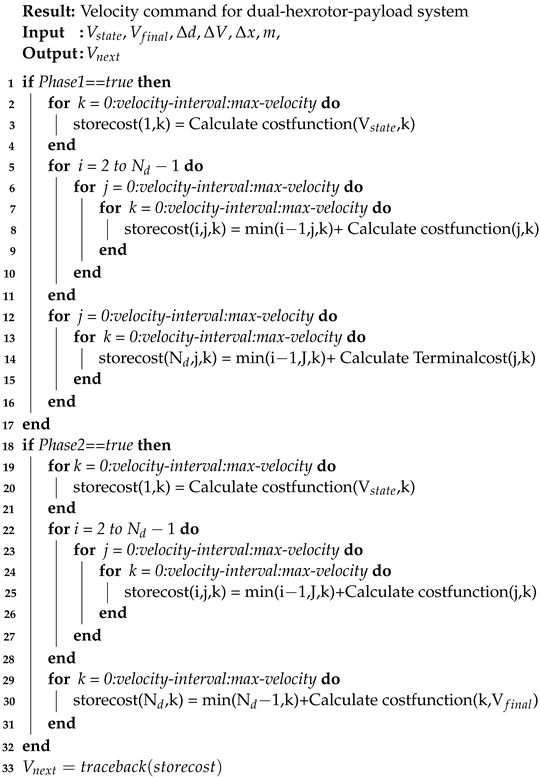 |
3.4. Cost Function Definition
4. Model Derivation for Cost Function
| Algorithm 2: Power cost calculation for a state transition for dual-UAV payload system |
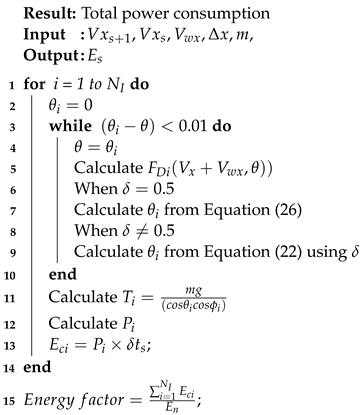 |
4.1. Time Domain to Distance Domain
4.1.1.
4.1.2.
4.2. Discretized Model for
4.3. Calculation of Time Spent
4.4. Parameter Selection for the Algorithm
4.4.1. DP Sweep Trigger
4.4.2. Relative Position Compensator
4.4.3. Constraints
5. Numerical Experiments
5.1. Payload Model
5.2. Assumptions
5.3. Numerical Simulation Results
6. Software in the Loop Simulations
SITL Experiments
7. Hardware Experiments
7.1. Base Case Experiment
7.2. Experiments for Dual-UAV RTDP Transportation
8. Conclusions
Author Contributions
Funding
Data Availability Statement
Acknowledgments
Conflicts of Interest
Abbreviations
| CoG | Center of gravity |
| UAV | Unmanned aerial vehicles |
| SITL | Software in the loop |
| RTDP | Real-time dynamic programming |
| EPM | Electro Permanent Magnet |
| ESC | Electronic speed controller |
References
- Kim, S.; Seo, H.; Choi, S.; Kim, H.J. Vision-guided aerial manipulation using a multirotor with a robotic arm. IEEE/ASME Trans. Mechatron. 2016, 21, 1912–1923. [Google Scholar] [CrossRef]
- Mellinger, D.; Shomin, M.; Michael, N.; Kumar, V. Cooperative Grasping and Transport using Multiple Quadrotors. In Distributed Autonomous Robotic Systems: The 10th International Symposium; Springer: Berlin/Heidelberg, Germany, 2015; Volume 83, pp. 545–558. [Google Scholar] [CrossRef]
- Maza, I.; Kondak, K.; Bernard, M.; Ollero, A. Multi-UAV cooperation and control for load transportation and deployment. J. Intell. Robot. Syst. Theory Appl. 2010, 57, 417–449. [Google Scholar] [CrossRef]
- Fink, J.; Michael, N.; Kim, S.; Kumar, V. Planning and control for cooperative manipulation and transportation with aerial robots. Springer Tracts Adv. Robot. 2011, 70, 643–659. [Google Scholar] [CrossRef]
- Michael, N.; Fink, J.; Kumar, V. Cooperative manipulation and transportation with aerial robots. Auton. Robot. 2010, 30, 73–86. [Google Scholar] [CrossRef]
- Jiang, Q.; Kumar, V. The inverse kinematics of cooperative transport with multiple aerial robots. IEEE Trans. Robot. 2013, 29, 136–145. [Google Scholar] [CrossRef]
- Gassner, M.; Cieslewski, T.; Scaramuzza, D. Dynamic Collaboration without Communication: Vision-Based Cable-Suspended Load Transport with Two Quadrotors. In Proceedings of the IEEE International Conference on Robotics and Automation (ICRA), Singapore, 29 May–3 June 2017; pp. 5196–5202. [Google Scholar] [CrossRef]
- Tagliabue, A.; Kamel, M.; Verling, S.; Siegwart, R.; Nieto, J. Collaborative transportation using MAVs via passive force control. In Proceedings of the 2017 IEEE International Conference on Robotics and Automation (ICRA), Singapore, 29 May–3 June 2017; pp. 5766–5773. [Google Scholar] [CrossRef]
- Zhang, X.; Zhang, F.; Huang, P.; Gao, J.; Yu, H.; Pei, C.; Zhang, Y. Self-triggered based coordinate control with low communication for tethered multi-UAV collaborative transportation. IEEE Robot. Autom. Lett. 2021, 6, 1559–1566. [Google Scholar] [CrossRef]
- Lee, H.; Kim, H.; Kim, H.J. Planning and control for collision-free cooperative aerial transportation. IEEE Trans. Autom. Sci. Eng. 2016, 15, 189–201. [Google Scholar] [CrossRef]
- Hegde, A.; Ghose, D. Multi-UAV collaborative transportation of payloads with obstacle avoidance. IEEE Control Syst. Lett. 2021, 6, 926–931. [Google Scholar] [CrossRef]
- Webb, K.; Rogers, J. Adaptive Control Design for Multi-UAV Cooperative Lift Systems. J. Aircr. 2021, 58, 1302–1322. [Google Scholar] [CrossRef]
- Doakhan, M.; Kabganian, M.; Azimi, A. Cooperative Payload Transportation with Flexible Formation Control of Multi-Quadrotors. Available at SSRN 4222094. Available online: https://papers.ssrn.com/sol3/papers.cfm?abstract_id=4222094 (accessed on 31 July 2019).
- Liu, Y.; Zhang, F.; Huang, P.; Zhang, X. Analysis, planning and control for cooperative transportation of tethered multi-rotor UAVs. Aerosp. Sci. Technol. 2021, 113, 106673. [Google Scholar] [CrossRef]
- Mohiuddin, A.; Tarek, T.; Zweiri, Y.; Dongming, G. Energy distribution in Dual-UAV collaborative transportation through load sharing. ASME J. Mech. Robot. 2020, 12, 1–14. [Google Scholar] [CrossRef]
- Dai, X.; Quan, Q.; Ren, J.; Cai, K.Y. Efficiency Optimization and Component Selection for Propulsion Systems of Electric Multicopters. IEEE Trans. Ind. Electron. 2018, 66, 7800–7809. [Google Scholar] [CrossRef]
- Masroor, R.; Naeem, M.; Ejaz, W. Resource management in UAV-assisted wireless networks: An optimization perspective. Ad Hoc Netw. 2021, 121, 102596. [Google Scholar] [CrossRef]
- Sharma, B.; Srivastava, G.; Lin, J.C.W. A bidirectional congestion control transport protocol for the internet of drones. Comput. Commun. 2020, 153, 102–116. [Google Scholar] [CrossRef]
- Sajid, M.; Mittal, H.; Pare, S.; Prasad, M. Routing and scheduling optimization for UAV assisted delivery system: A hybrid approach. Appl. Soft Comput. 2022, 126, 109225. [Google Scholar] [CrossRef]
- Sharma, B.; Obaidat, M.S.; Sharma, V.; Hsiao, K.F. Routing and collision avoidance techniques for unmanned aerial vehicles: Analysis, optimal solutions, and future directions. Int. J. Commun. Syst. 2020, 33, e4628. [Google Scholar] [CrossRef]
- Stolaroff, J.K.; Samaras, C.; O’Neill, E.R.; Lubers, A.; Mitchell, A.S.; Ceperley, D. Energy use and life cycle greenhouse gas emissions of drones for commercial package delivery. Nat. Commun. 2018, 9, 409. [Google Scholar] [CrossRef]
- Hegde, A.; Ghose, D. Multi-Quadrotor Distributed Load Transportation for Autonomous Agriculture Spraying Operations. J. Guid. Control. Dyn. 2022, 45, 944–951. [Google Scholar] [CrossRef]
- Gimenez, J.; Gandolfo, D.C.; Salinas, L.R.; Rosales, C.; Carelli, R. Multi-objective control for cooperative payload transport with rotorcraft UAVs. ISA Trans. 2018, 80, 491–502. [Google Scholar] [CrossRef]
- Iglesias, R.B.; Regueiro, C.V.; Barro, S.; Rodriguez, G.; Nieto, A. Improved Control of DLO Transportation by a team of quadrotors. In Biomedical Applications Based on Natural and Artificial Computing, Proceedings of the International Work-Conference on the Interplay between Natural and Artificial Computation, IWINAC 2017, Corunna, Spain, 19-23 June 2017; Springer International Publishing: New York, NY, USA, 2017; Volume 10338, pp. 345–354. [Google Scholar] [CrossRef]
- Mohiuddin, A.; Tarek, T.; Zweiri, Y.; Dongming, G. UAV payload transportation via RTDP based optimized velocity profiles. Energies 2019, 12, 3049. [Google Scholar] [CrossRef]
- Raza, W.; Osman, A.; Ferrini, F.; Natale, F.D. Energy-Efficient Inference on the Edge Exploiting TinyML Capabilities for UAVs. Drones 2021, 5, 127. [Google Scholar] [CrossRef]
- Lee, H.; Kim, H.J. Constraint-Based Cooperative Control of Multiple Aerial Manipulators for Handling an Unknown Payload. IEEE Trans. Ind. Inform. 2017, 13, 2780–2790. [Google Scholar] [CrossRef]
- Horyna, J.; Baca, T.; Saska, M. Autonomous collaborative transport of a beam-type payload by a pair of multi-rotor helicopters. In Proceedings of the 2021 International Conference on Unmanned Aircraft Systems (ICUAS), Athens, Greece, 15–18 June 2021; pp. 1139–1147. [Google Scholar]
- Aydin, B.; Selvi, E.; Tao, J.; Starek, M.J. Use of Fire-Extinguishing Balls for a Conceptual System of Drone-Assisted Wildfire Fighting. Drones 2019, 3, 17. [Google Scholar] [CrossRef]
- Natesan, S.; Armenakis, C.; Benari, G.; Lee, R. Use of UAV-Borne Spectrometer for Land Cover Classification. Drones 2018, 2, 16. [Google Scholar] [CrossRef]
- del Cerro, J.; Cruz Ulloa, C.; Barrientos, A.; de León Rivas, J. Unmanned Aerial Vehicles in Agriculture: A Survey. Agronomy 2021, 11, 203. [Google Scholar] [CrossRef]
- Guo, Y.; Jiang, B.; Zhang, Y. A novel robust attitude control for quadrotor aircraft subject to actuator faults and wind gusts. IEEE/CAA J. Autom. Sin. 2017, 5, 292–300. [Google Scholar] [CrossRef]
- Peng, C.; Bai, Y.; Gong, X.; Gao, Q.; Zhao, C.; Tian, Y. Modeling and robust backstepping sliding mode control with Adaptive RBFNN for a novel coaxial eight-rotor UAV. IEEE/CAA J. Autom. Sin. 2015, 2, 56–64. [Google Scholar]
- Abdullah Mohiuddin. Dual UAV Payload Transportation Using RTDP Based Optimized Velocity Profiles. Available online: https://youtu.be/JjPNZcLU7RU (accessed on 31 July 2019).
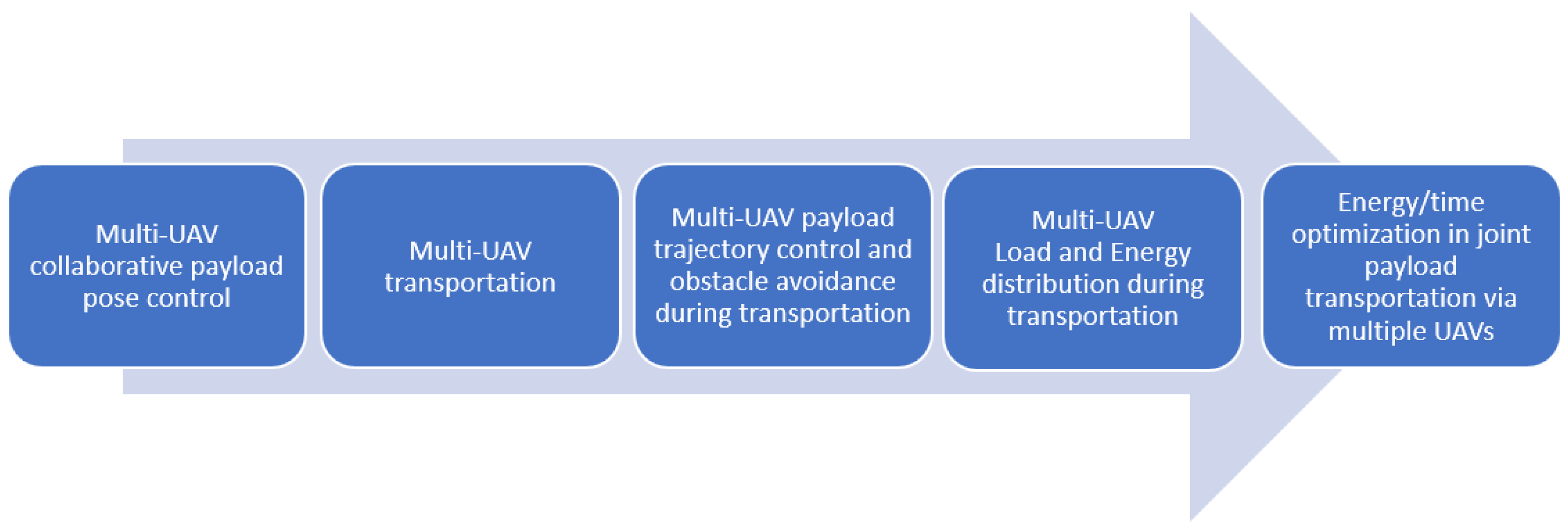

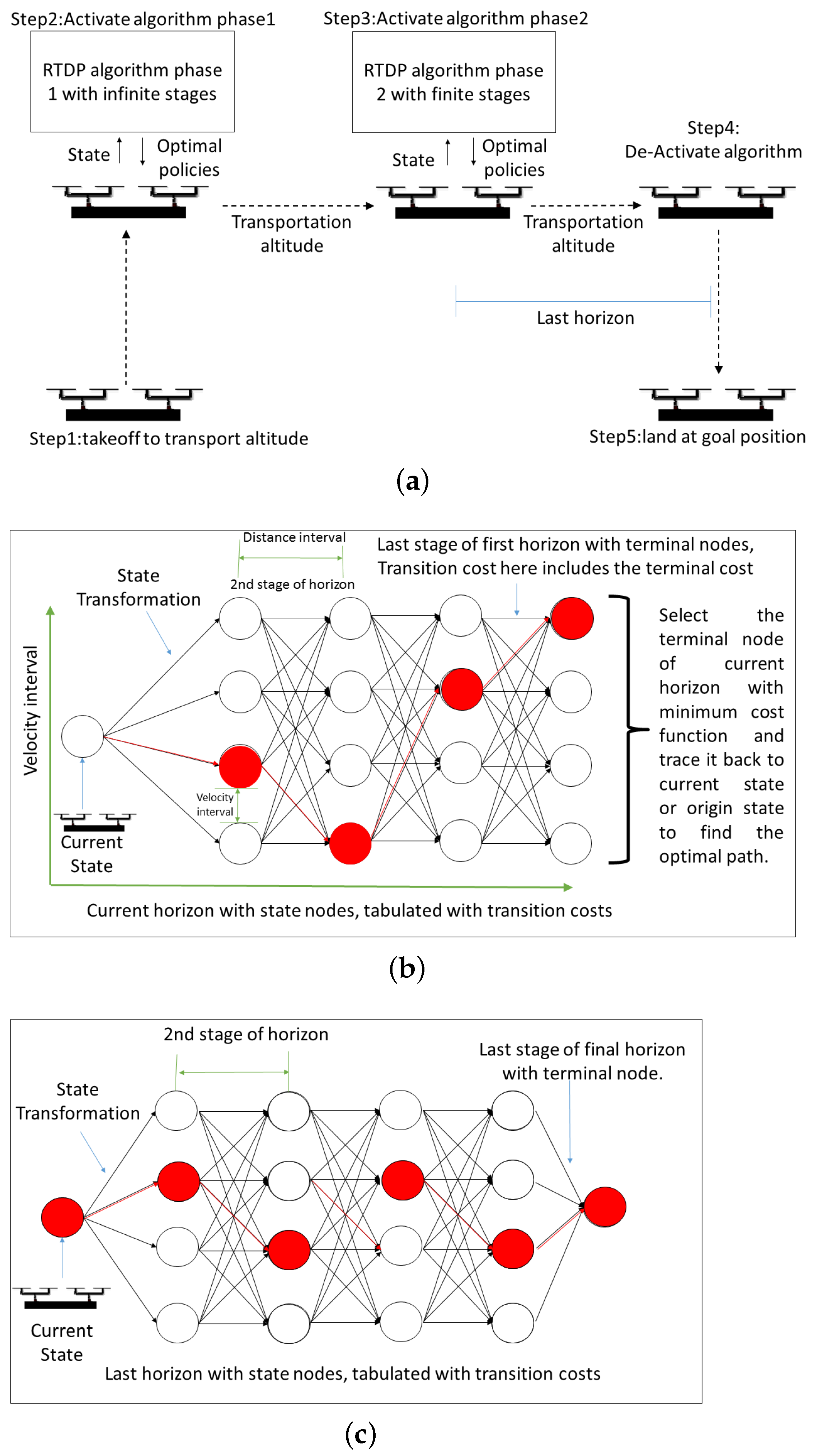
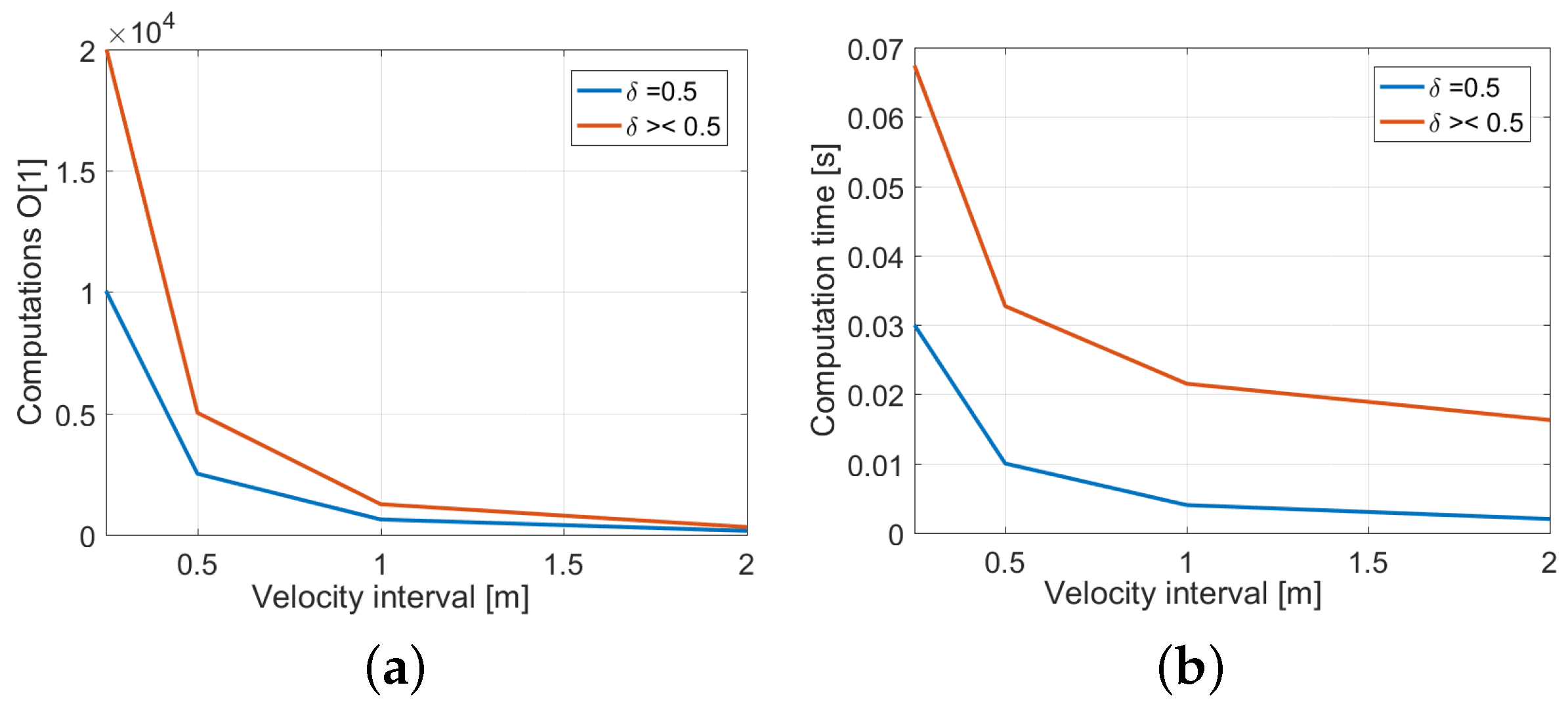
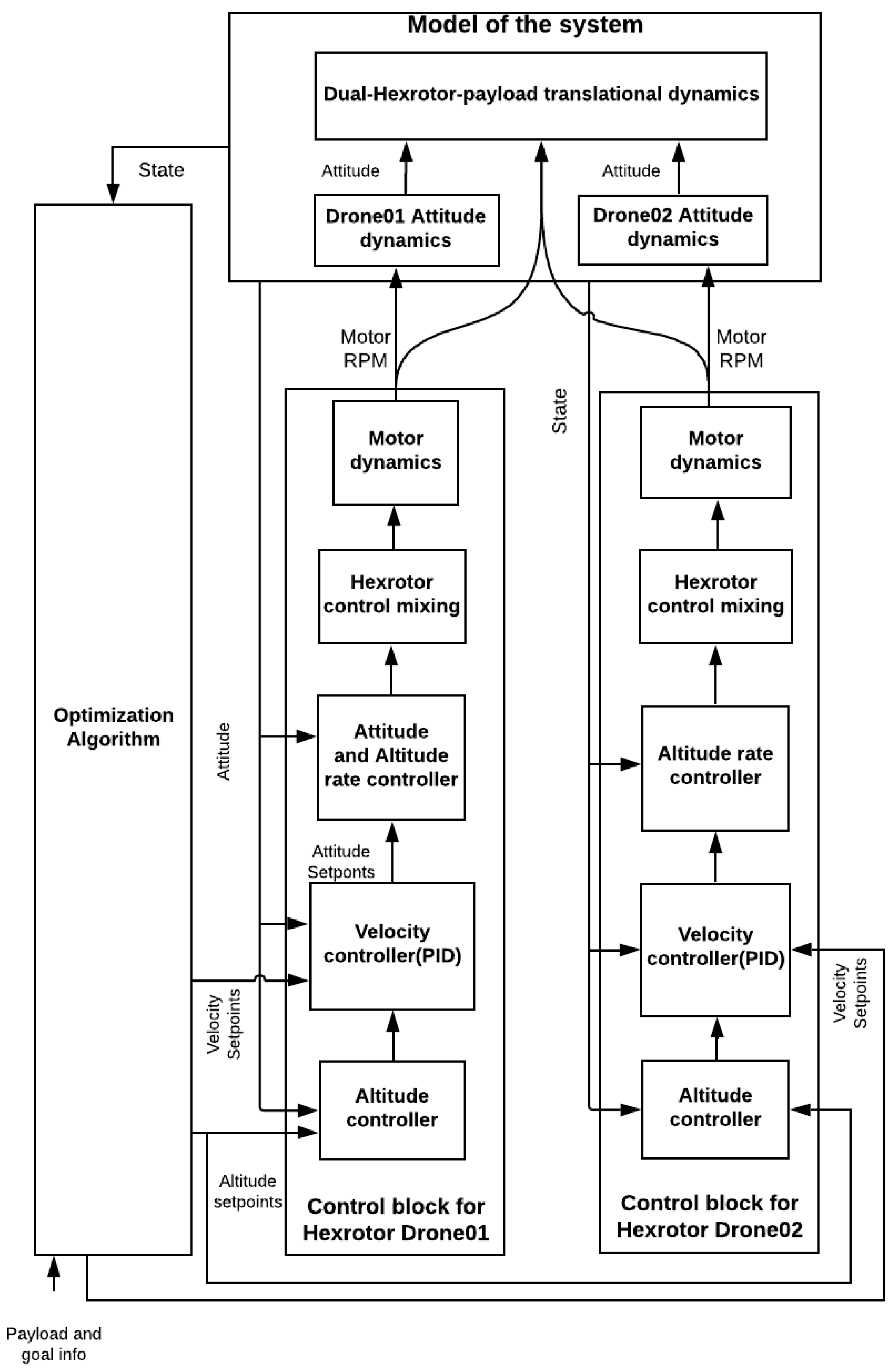
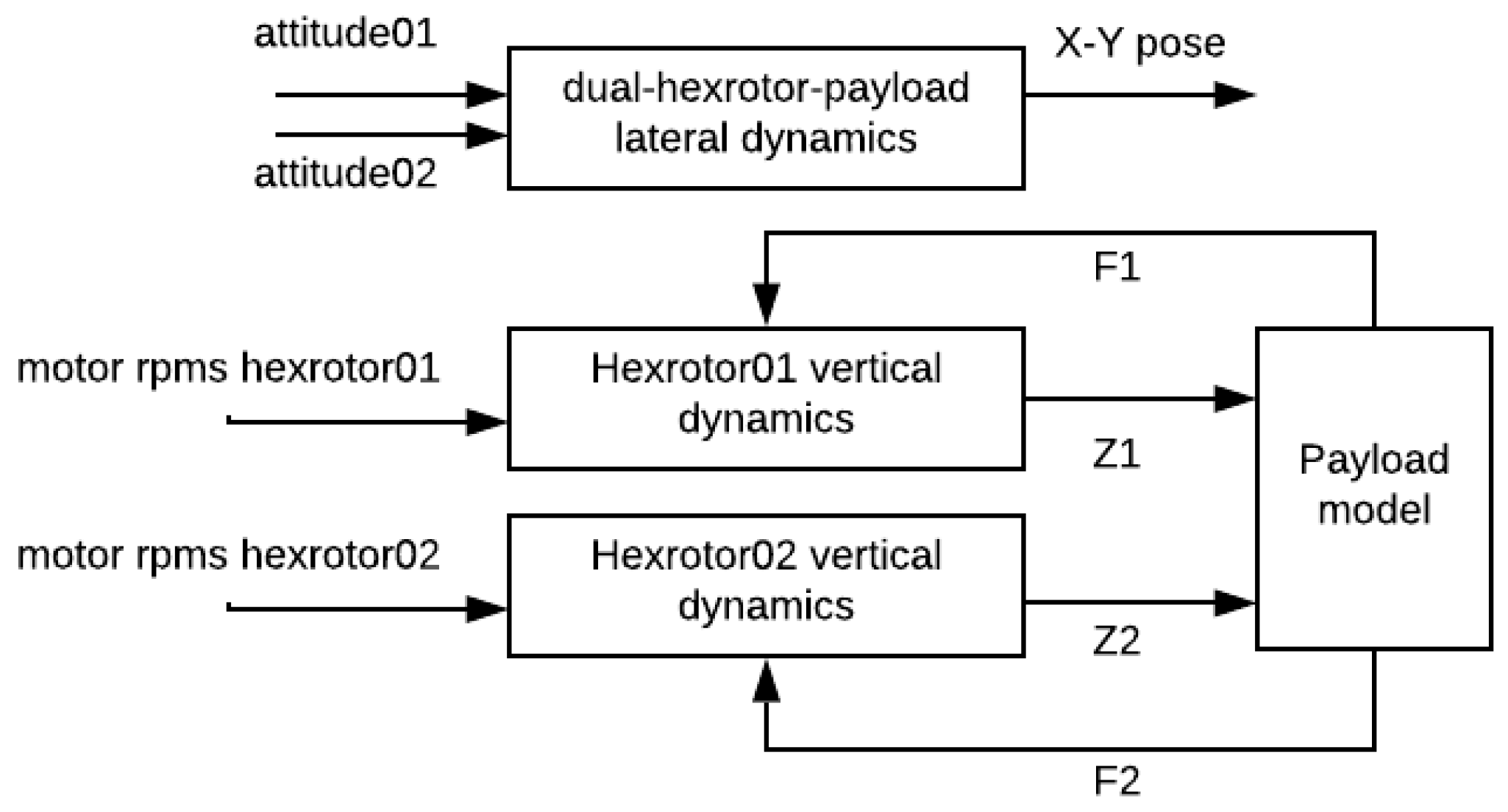
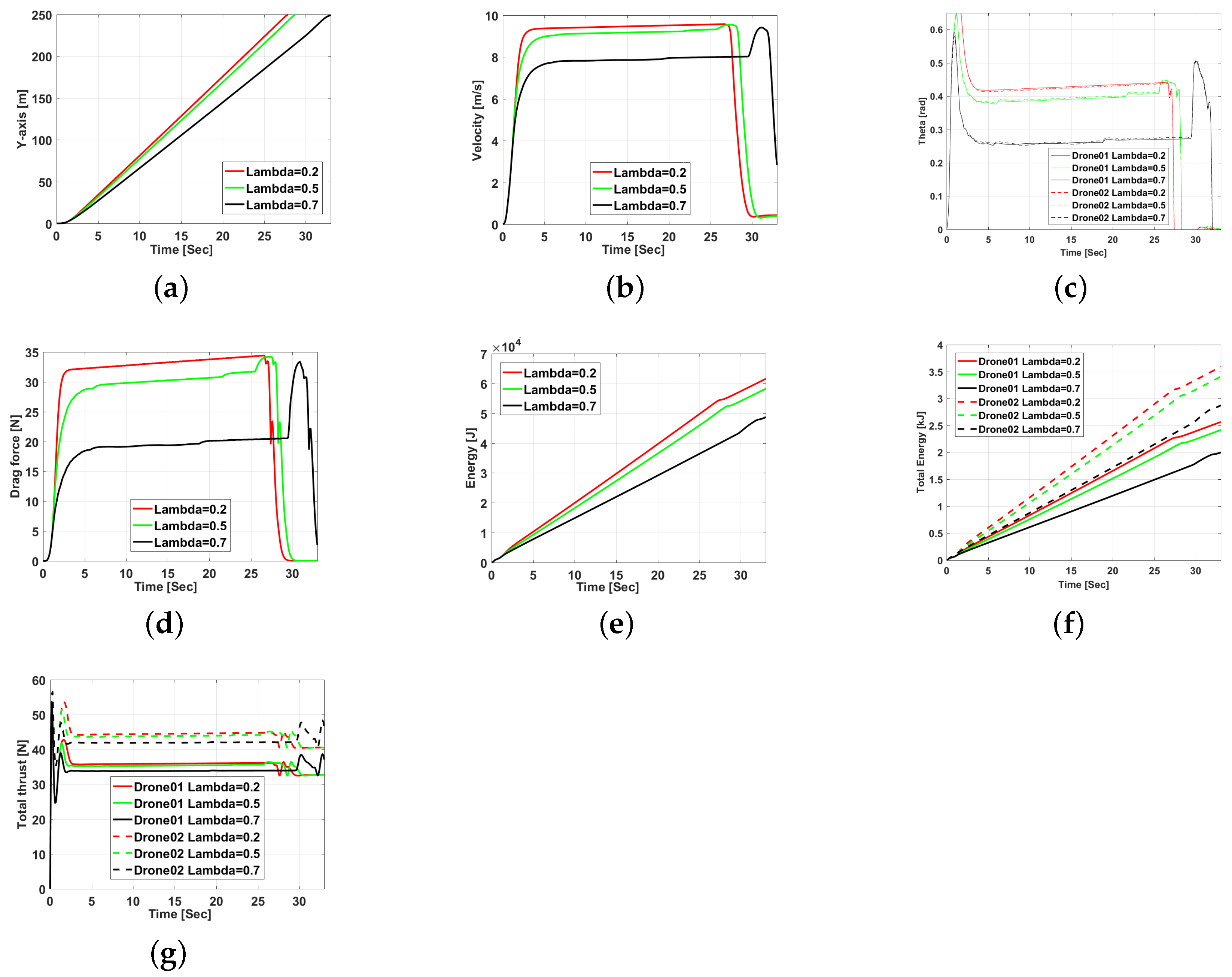
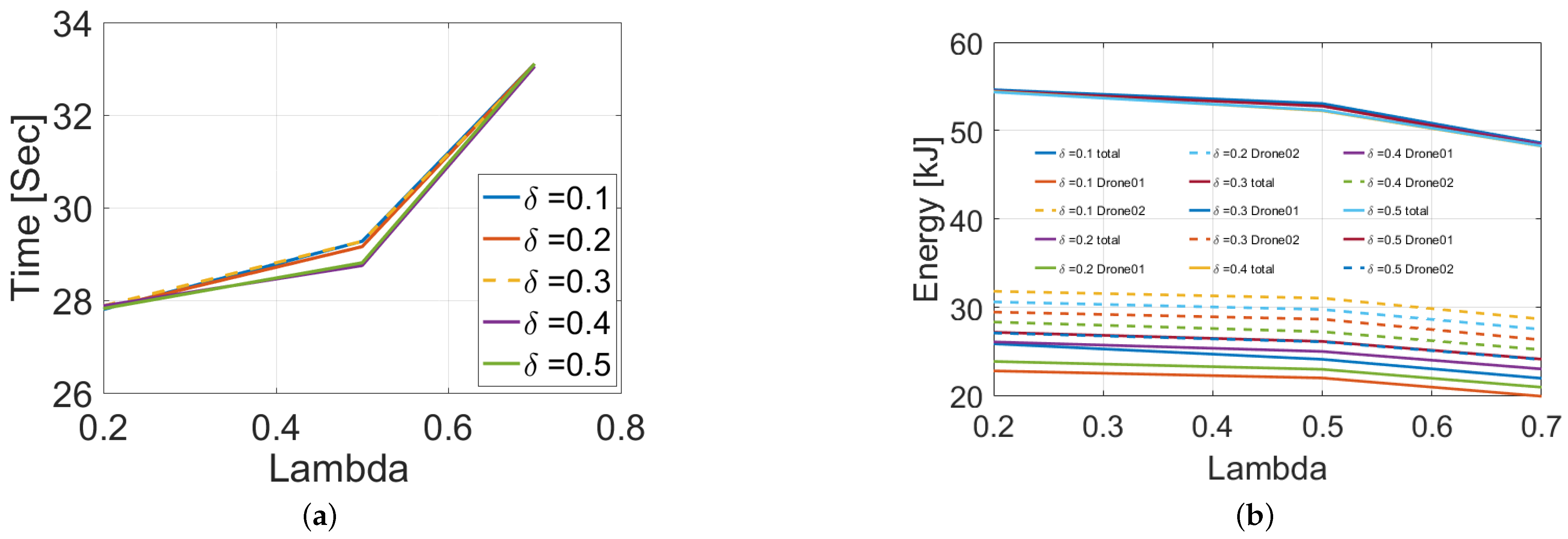

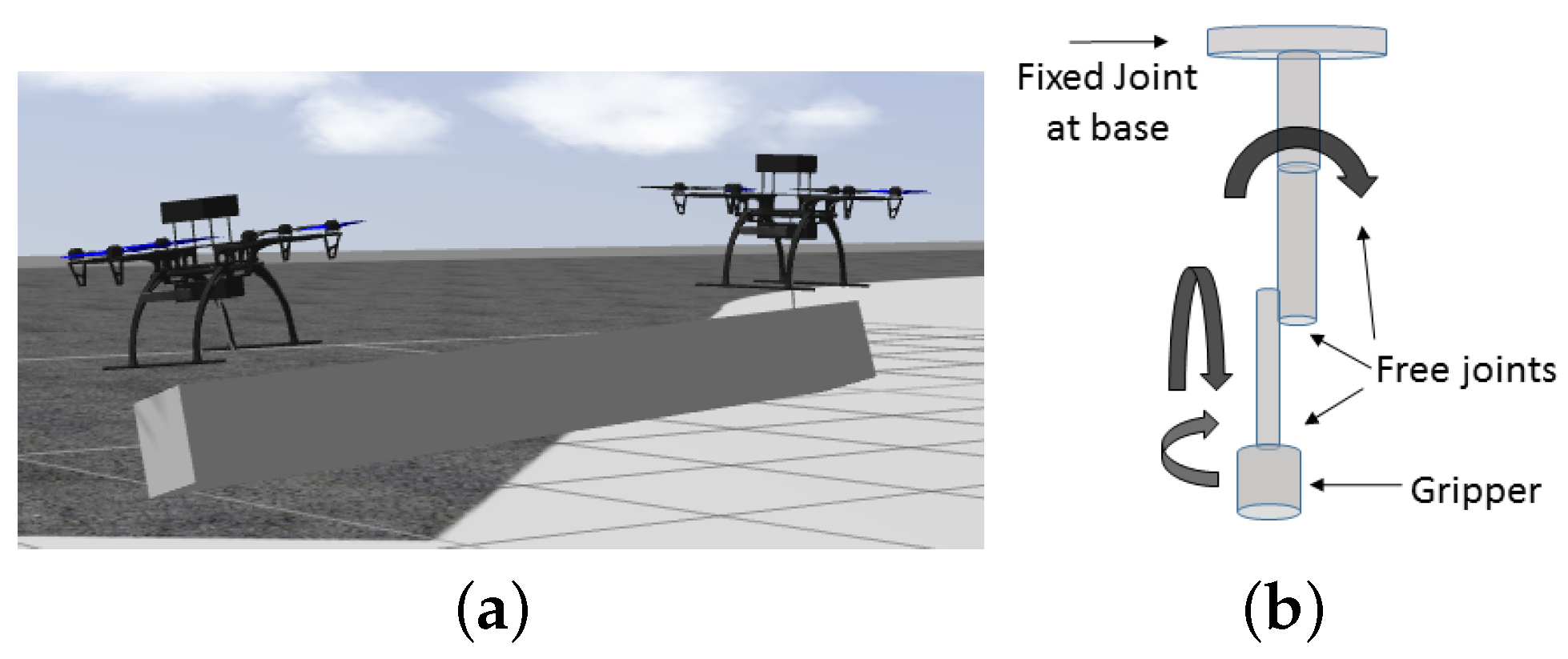
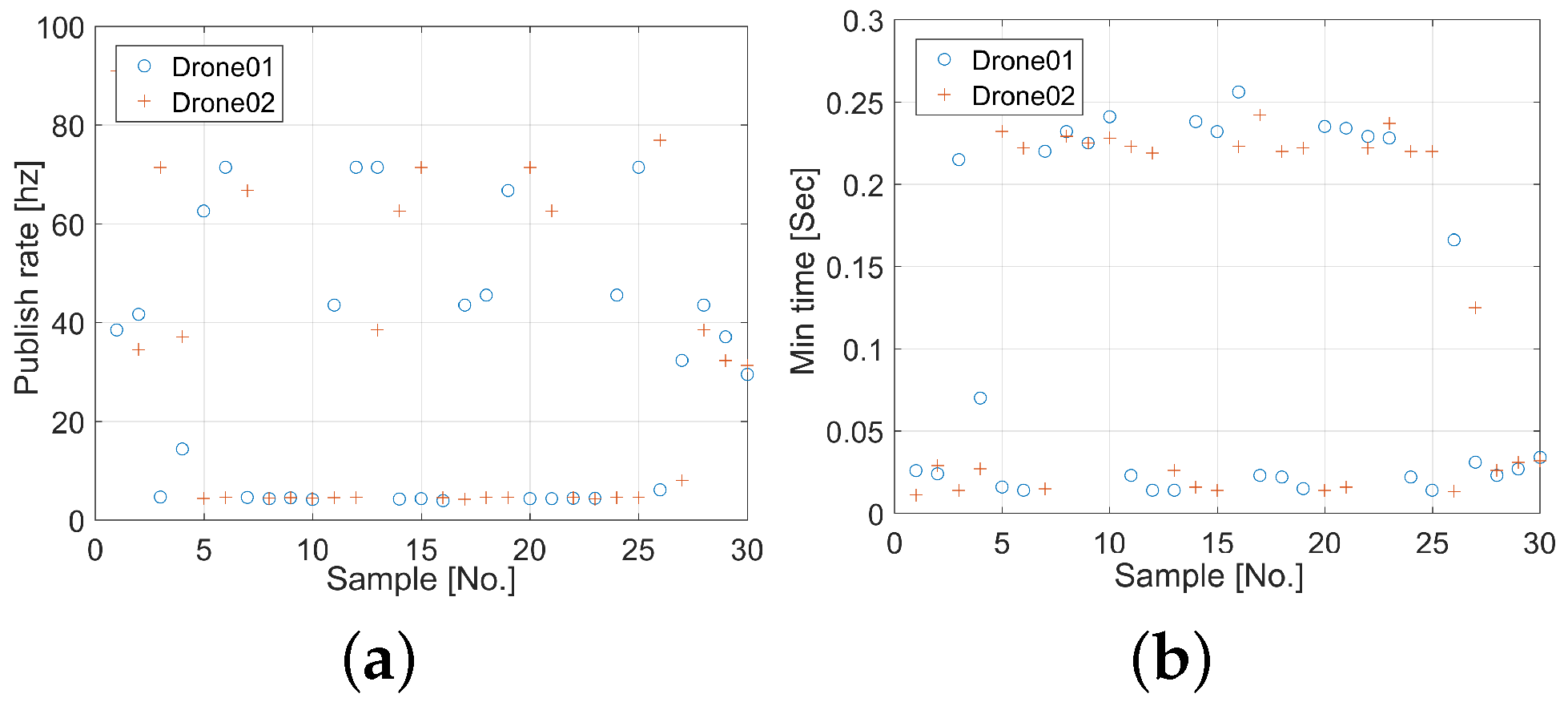
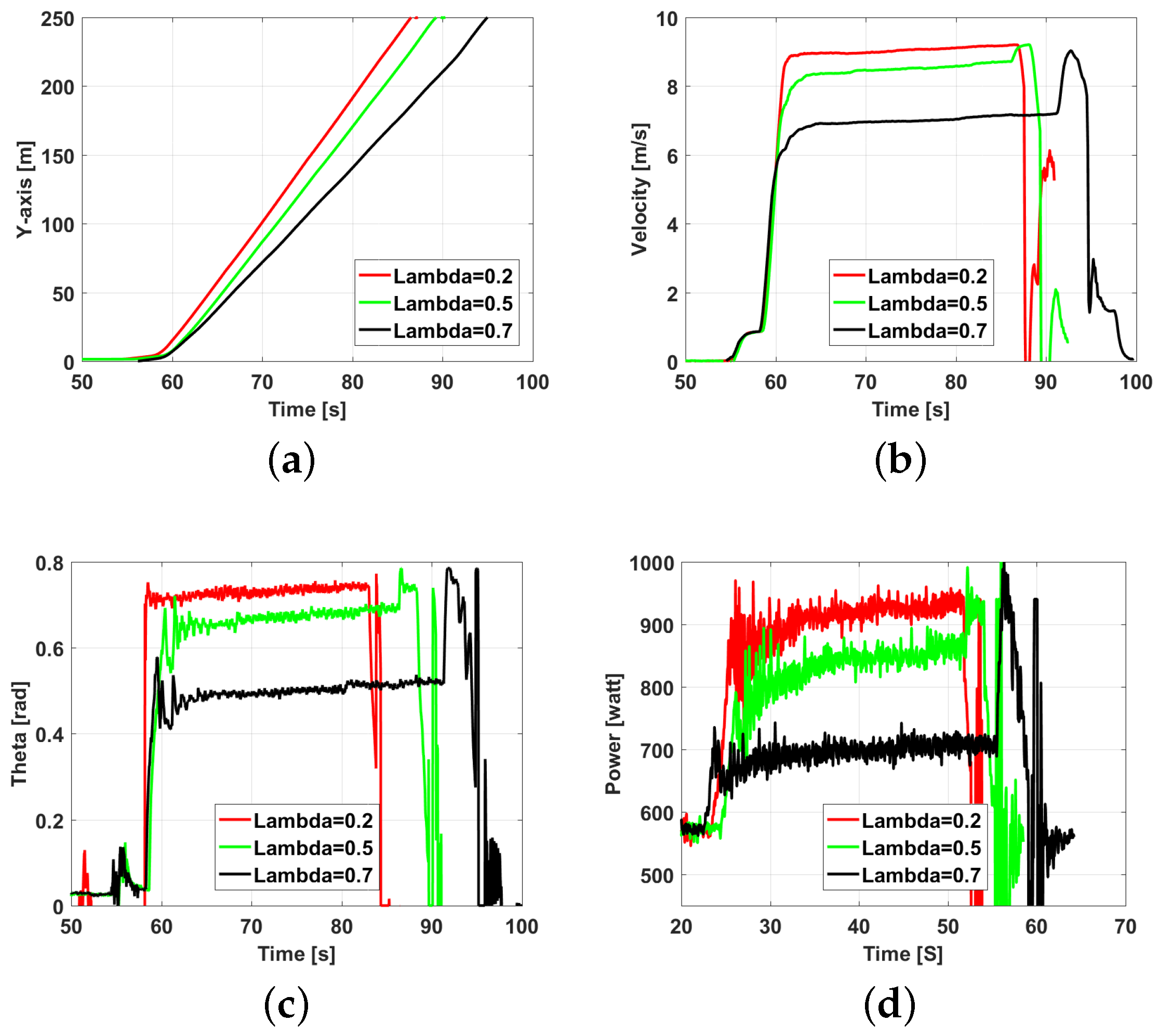
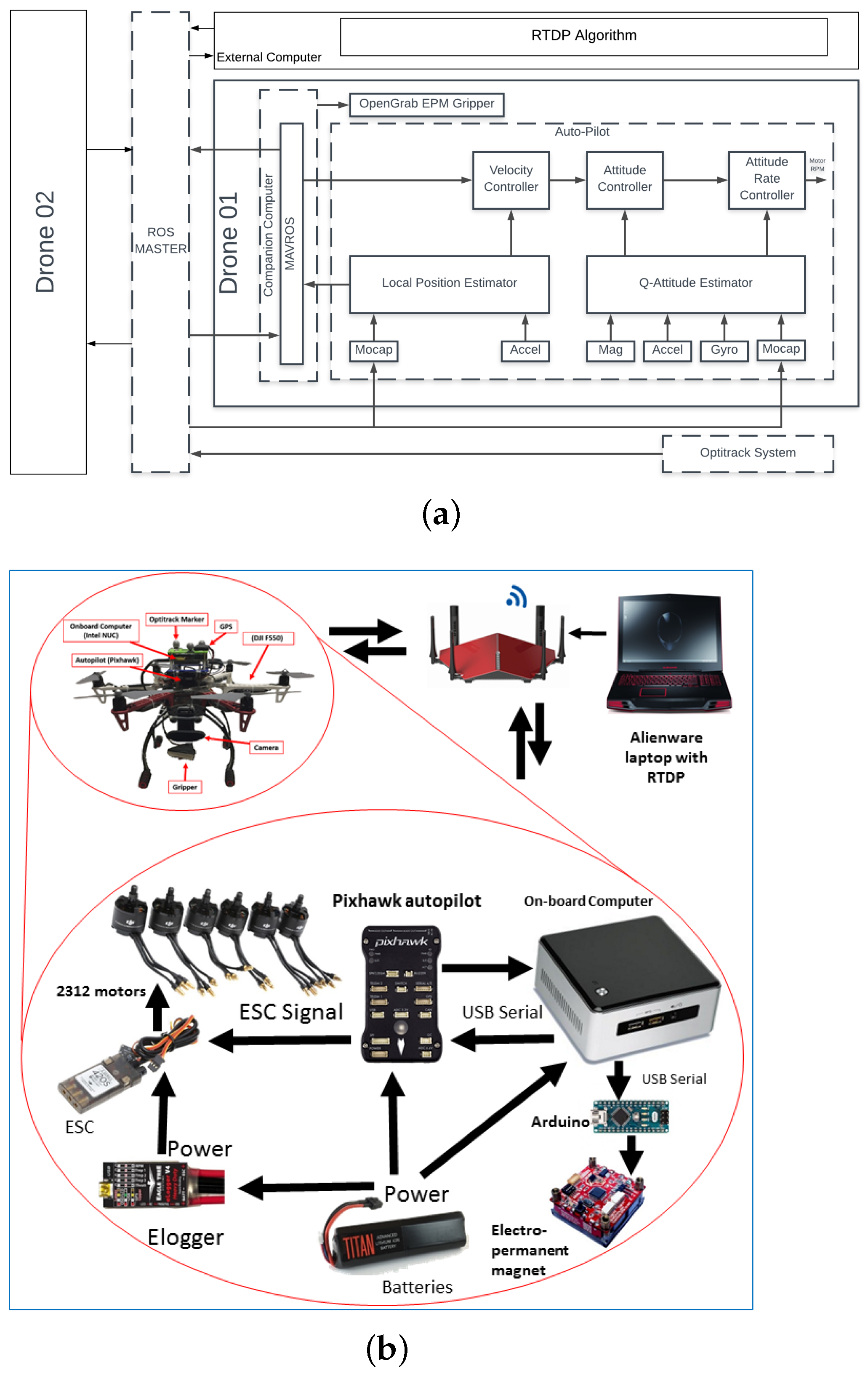
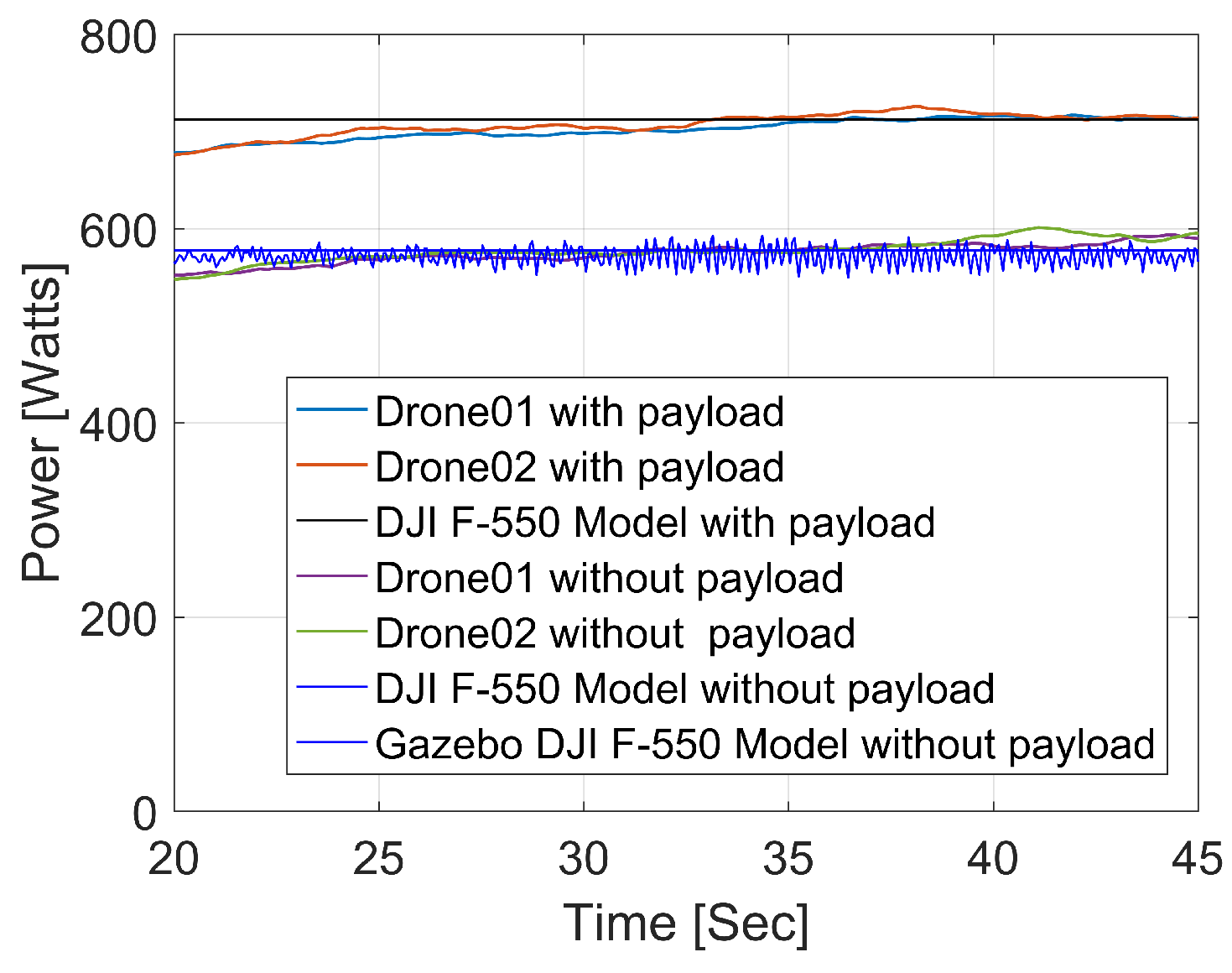
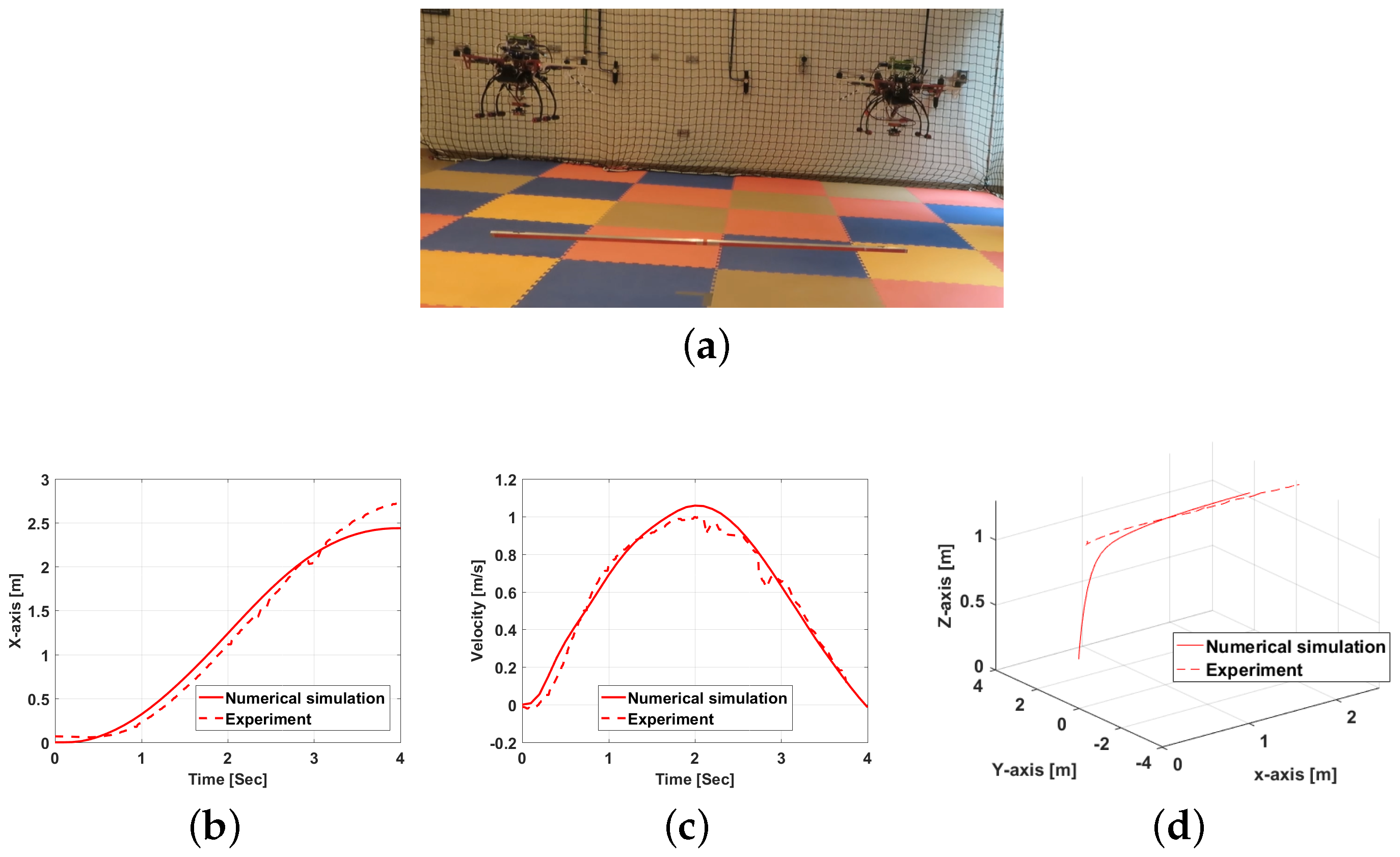

| Weight-Age | Time (s) | Time (%) | Energy (kJ) | Energy (%) | Velocity Interval (m/s) |
|---|---|---|---|---|---|
| % | 57.8 | % | 0.1 | ||
| 30.72 | 0 | 57.39 | 0 | 0.1 | |
| 34.73 | % | 54.8 | % | 0.1 |
| Weight-Age | Time (s) | Time (%) | Energy (kJ) | Energy (%) | Velocity Interval (m/s) |
|---|---|---|---|---|---|
| % | 54.57 | % | 0.1 | ||
| 28.7 | 0 | 52.5 | 0 | 0.1 | |
| 33 | % | 48.6 | % | 0.1 | |
| % | 54.65 | % | 0.2 | ||
| 28.983 | 0 | 52.46 | 0 | 0.2 | |
| 32.9 | % | 48.4 | % | 0.2 | |
| % | 55.78 | % | 0.3 | ||
| 29.27 | 0 | 52.48 | 0 | 0.3 | |
| 32.9 | % | 48.27 | % | 0.3 | |
| % | 55.87 | % | 0.4 | ||
| 29.215 | 0 | 53.04 | 0 | 0.4 | |
| 33.43 | % | 48.79 | % | 0.4 | |
| % | 54.65 | % | 0.5 | ||
| 29.15 | 0 | 52.67 | 0 | 0.5 | |
| 33.63 | % | 49.62 | % | 0.5 |
| Weight-Age | Time (s) | Time (%) | Energy (kJ) | Energy (%) | Velocity Interval (m/s) |
|---|---|---|---|---|---|
| % | 56.91 | % | 0.1 | ||
| 33.97 | 0 | 50 | 0 | 0.1 | |
| 39.24 | % | 52.06 | % | 0.1 |
| Weight-Age | Time (s) | Time (%) | Energy (kJ) | Energy (%) | Velocity Interval (m/s) |
|---|---|---|---|---|---|
| % | 49.37 | % | 0.1 | ||
| 40.44 | 0 | 52.24 | 0 | 0.1 | |
| 47.45 | % | 60 | % | 0.1 |
Disclaimer/Publisher’s Note: The statements, opinions and data contained in all publications are solely those of the individual author(s) and contributor(s) and not of MDPI and/or the editor(s). MDPI and/or the editor(s) disclaim responsibility for any injury to people or property resulting from any ideas, methods, instructions or products referred to in the content. |
© 2023 by the authors. Licensee MDPI, Basel, Switzerland. This article is an open access article distributed under the terms and conditions of the Creative Commons Attribution (CC BY) license (https://creativecommons.org/licenses/by/4.0/).
Share and Cite
Mohiuddin, A.; Taha, T.; Zweiri, Y.; Gan, D. Dual-UAV Payload Transportation Using Optimized Velocity Profiles via Real-Time Dynamic Programming. Drones 2023, 7, 171. https://doi.org/10.3390/drones7030171
Mohiuddin A, Taha T, Zweiri Y, Gan D. Dual-UAV Payload Transportation Using Optimized Velocity Profiles via Real-Time Dynamic Programming. Drones. 2023; 7(3):171. https://doi.org/10.3390/drones7030171
Chicago/Turabian StyleMohiuddin, Abdullah, Tarek Taha, Yahya Zweiri, and Dongming Gan. 2023. "Dual-UAV Payload Transportation Using Optimized Velocity Profiles via Real-Time Dynamic Programming" Drones 7, no. 3: 171. https://doi.org/10.3390/drones7030171
APA StyleMohiuddin, A., Taha, T., Zweiri, Y., & Gan, D. (2023). Dual-UAV Payload Transportation Using Optimized Velocity Profiles via Real-Time Dynamic Programming. Drones, 7(3), 171. https://doi.org/10.3390/drones7030171






